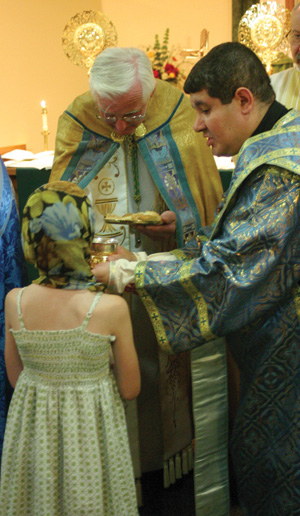By Celine Klosterman

COLUMBUS JUNCTION – As incense rose in St. Joseph Church, 130 Catholics chanted prayers of praise and intercession Sept. 7 during a Byzantine Divine Liturgy that offered Davenport Diocese parishioners a rare opportunity to experience the Eastern Church.
Flanked by altar servers wearing gold robes and holding candles, Father Ezzat Batouche, Deacon Sergio Ayala and Deacon Fadi Rafidi opened the celebration by leading the congregation in singing the Great Doxology, a hymn similar to the Gloria of the Roman Mass.
Deacon Ayala is chaplain at Tyson Foods in Columbus Junction and a minister at St. John the Baptist Melkite Greek Catholic Church in Northlake, Ill., where Fr. Batouche and Deacon Rafidi serve. Bishop Martin Amos and Deacon Frank Agnoli, director of liturgy for the diocese, also participated in the Divine Liturgy of St. John Chrysostom.
The congregation, who faced the same direction as the liturgy’s celebrants, stood for most of the celebration as they chanted responses printed in booklets in Arabic and either English or Spanish. The Melkite Byzantine community has Arabian and Greek heritage, and St. Joseph Parish is largely Hispanic.
The liturgy included two Scripture readings – an Epistle and Gospel – and a homily from Bishop Amos. He noted that the liturgy celebrated the Byzantine feast of The Nativity of our Most Holy Lady, the Mother of God and Ever-Virgin Mary, nine months after the Byzantine celebration of the Conception of the Most Holy Mother of God by the Righteous Anna.
Pope Clement XI prayed: “I want to do what you ask of me, in the way you ask, for as long as you ask, because you ask it,” the bishop noted. “That was Mary’s response, and it must be ours too.”
Catholics later recited the Lord’s Prayer, shared the “kiss,” or sign, of peace and professed the Niceno-Constantinopolitan Creed. During the Liturgy of Holy Communion, Fr. Batouche and Bishop Amos distributed the Eucharist in the form of leavened bread dipped into the chalice. As congregants received Communion by tongue, the celebrants said, “Handmaid/servant (female/male) of God, receive the Body and Blood of our Lord and Savior Jesus Christ.”
To end the liturgy, Catholics stood in procession to venerate a cross held by Fr. Batouche, who blessed each of them.
For Clara Oleson of West Branch, the celebration showed the universality and diversity of the Catholic Church. “Getting access to the sacred in different forms is rewarding. It should refresh our hearts,” she said.
She also appreciated the ornate blue and gold robes worn by the liturgy’s celebrants. “Textiles in the Latin Church have gone towards simplicity,” she said.
Upon hearing a Divine Liturgy would be celebrated in Columbus Junction, Lynsey Kemner of Clarence teared up, she said. It’s not often her family of eight gets to receive the Eucharist in the form in which it’s distributed in their Byzantine Catholic tradition, she explained. She and her husband, Adam, a student in the Master of Pastoral Theology program at St. Ambrose University in Davenport, take their children once or twice a year to a Byzantine church in Aurora, Ill. But most often, they attend Roman Catholic Mass in Tipton or Mechanicsville.
Adam Kemner, who has Slavic background, belongs to the Ruthenian Byzantine community. Burlington resident Bob Huschak, who has Rusyn heritage, is also most accustomed to the Ruthenian Church, but said he was happy to participate in the Melkite Byzantine celebration in Columbus Junction.
“Regardless of the church, I continue to feel the Byzantine liturgy is very appealing to the heart, mind and body with an explosion of the senses,” he said. In Byzantine church buildings, “icons are everywhere keeping the eyes moving to admire the beauty of those captured in the paintings, while incense fills the air and rises to heaven. This all takes place while songs are sung acapella, beseeching the Lord for his mercy and intercession.”
Bishop Amos said the Divine Liturgy offered a reminder that there are Catholic rites other than Roman. Having participated in Byzantine liturgies in seminary and elsewhere, he said the celebrations can be challenging to follow, but moving. “In listening to people after the Divine Liturgy, I heard that they were very moved by its otherworldliness and the prayers.”







